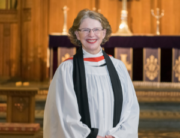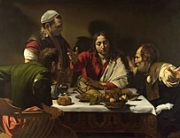A sermon given during the 6:00pm Choral Evensong, by The Rev’d Dr Lynn Arnold AO, on the 2nd April 2023.
LAST HOMELY HOUSE FOR JESUS
May the words of my mouth and the meditations of our hearts be worthy in your sight, O Lord, our Rock and our Redeemer. Amen.
At our two services this morning we had the liturgical celebration and remembrance of Jesus’ grand entry into Jerusalem just days before he would preside over a Passover meal, be arrested, tried and crucified; then rise on the third day. Through all the liturgical events which we will have this week tracing that journey to the moment where we will exclaim ‘He is Risen!’, we will feel awe at the love of God for his Creation not only because he ‘gave his only Son, that whoever believes in him should not perish but have eternal life’ as we read in John 3:16, but that he would do so in such a humbling and sacrificial way. For us truly to appreciate the awesomeness of the way in which he gave this gift, we need to appreciate that in giving us his Son, Jesus ‘was made man’ as we say in the Nicene Creed; he was flesh and blood, not just a divine apparition.
There is a theological concept known as ‘hypostatic union’ (from the Greek ὑπόστασις hypostasis) which can be summarised as ‘Jesus Christ being both fully God and fully human … (but that) he has two complete and distinct natures.’ Thus, it was this ‘fully human’ Jesus who wept upon hearing the death of Lazarus, who was woebegone in the Garden of Gethsemane and who cried out in despair on the Cross. It could also have been this ‘fully human’ Jesus whom we read acted strangely out of character in those days surrounding his grand entry into Jerusalem. For not only had He raged against the traders in the outer court of the temple in a display of very human temper [Matthew 21:17 & Mark 11:15], he had also vented his spleen on a hapless fig tree, withering it for failing, out-of-season though it was, to provide fruit for the hungry Jesus. [Mark 11:12-14; Matthew 21:18-22]
This evening, I want us to reflect upon the ‘fully human’ in Jesus during one aspect of that week as he prepared both himself and his followers for his crucifixion. Amidst all the stress and clamour that seemed to surround Jesus as he went about his ministry, which had undoubtedly increased in those final weeks, it should not surprise us that his human side would have craved some tranquillity. This he would find, as he had found it before, with his beloved friends, the siblings Lazarus, Martha and Mary. Through different references in Scripture, we know that he often visited them; and those visits have reminded me of Tolkein’s reference, in the Fellowship of the Ring, to ‘the last homely house’, leading me to think that perhaps Bethany had been such a place for Jesus. To explain, J R R Tolkein described such a sanctuary this way:
Frodo was now safe in the Last Homely House east of the Sea. That house was, as Bilbo had long ago reported, ‘a perfect house, whether you like food or sleep, or story-telling or singing, or just sitting and thinking best, or a pleasant mixture of them all. Merely to be there was a cure for weariness, fear and sadness.
We read in John 11:5 that Jesus loved Martha, her sister Mary and Lazarus; so their home became a place where he could stay, enjoy their company and perhaps just sit, taking time out away from the fray. In the nights he stayed there during Passion Week, it would also have provided some balm for his own human ‘weariness, fear and sadness’.
Of course, Jesus always had his constant companions, the disciples and the others who followed him around on his ministry, like Mary Magdalene. But there seems to have been something special in the friendship with these three from Bethany. It seems to me that the difference offered by his time spent with them was a time seeped with the deep simplicity of their faith and the relaxed naturalness of their reactions to him. Perhaps their company was easier to enjoy, more relaxing for Jesus than that of his ever-earnest disciples.
We first encounter the family in Luke 10: 38-42, when a very family situation was reported, with Martha complaining to Jesus that Mary wouldn’t help her with the dishes. The next encounter was traumatic but profoundly edifying – the death of Lazarus, brother of Martha and Mary. The episode, as related in John 11 gives insight into how trusting this family was about their friend Jesus. Recall Martha’s words upon Jesus arriving; with Lazarus still dead in his tomb, not yet raised, she had said to him:
Lord, I believe that You are the Christ, the Son of God, who is to come into the world. [John 11:27]
These were grand words, but they speak more of trust than theological knowledge; for, as her sister Mary would say ever so simply a short while later:
Lord, if you had been here, my brother would not have died. [John 11:32]
The next reported encounter was on the evening before his planned entry to Jerusalem, which was read in our Gospel reading tonight. On this occasion, we know at least some of the disciples were there as well, Judas Iscariot for certain. We know that, for he was the odd voice out in the house as he complained about the expensive balm being used on Jesus’ feet by Mary. None of the family had joined in that complaint, for this was their adored friend he was talking about.
Then came the big day of the entry to Jerusalem, with huge crowd interest not least caused by the report of Lazarus’ resurrection only weeks earlier, as we read in John 12:17-18. On the more ominous side, that very resurrection had also been a catalyst for the religious officials to escalate their attempt to bring Jesus down [John 11:53]:
Then from that day on, they plotted to put Jesus to death.
As a consequence, the size of the crowds and their shouts of praise greatly agitated the religious elite, but Jesus carried on regardless, doubtless with Lazarus in the parade. Strangely, Scripture is largely silent as to what happened after the great procession was over. Matthew had said it was then that Jesus acted riotously in the Temple courtyard, but Mark, who said that event occurred the next day, wrote simply that:
Jesus went into the temple … when He had looked around at all things, as the hour was already late, He went out to Bethany with the twelve. [Mark 11:11]
What happened to the crowd after all the huzzah of the grand entry? Did they just fade away back in the streets and alleys of Jerusalem? Scripture is silent on what the crowd did or did not do after all the high emotion of shouting:
Hosanna! Blessed is He who comes in the name of the Lord, the King of Israel. [John 12:13]
All we know is that Jesus went back to his friends. Perhaps, Scripture is silent because the crowd was never meant to be the key topic; so perhaps, we are to ponder not the crowd psychology of the moment, but the personal import. Certainly, the general tenor of John’s gospel always seems to bring the focus back to each of us rather than to all of us. David Pawson, in his book ‘Unlocking the Bible: a unique overview of the whole Bible’, has noted that:
John includes more stories about individuals and a number of these are unique to his gospel … indeed … one-to-one dialogues are given more prominence than the meetings with crowds which seem to dominate the other three gospels. [p888]
No crowd story, just Jesus going back to Bethany. What did Mary, Martha and Lazarus say about the day’s astounding events? Perhaps they said nothing; perhaps Jesus didn’t want to talk about what had happened. Perhaps his human side was feeling frustrated at how the crowd had so misunderstood his mission – that it was not to be an earthly potentate but a divine saviour. Perhaps that might explain why he was so crotchety the next day walking on the way to Jerusalem, condemning a fig tree, and ruining the day’s trading in the Temple courtyard.
A lot of ‘perhaps’ in what I have just said. I think though that when the Bible falls silent on how events transpired, it is because the writers want to bring us into the story. In terms of who said or thought what during the next two nights that Jesus stayed with his friends, instead of being told what happened, we are invited to place ourselves in their situation, use our imagination and reflect.
So there we are, in Bethany, on the night of Palm Sunday, and again on the Monday night after Jesus lost his temper twice. Not yet knowing how the subsequent days were going to pan out, what might we have been thinking?
This is more than just an exercise in creative imagination, for it invites us to move beyond treating Passion Week as a mere series of events, to being a pilgrimage of spiritual seeking. This morning, we partied with palms about the messiah coming; then next Sunday, we will joyously exclaim ‘He is Risen! He is Risen indeed!’ But between those two events of acclamation should be a dreadful journey in which we are invited to participate. Will we fall along the way, as Peter did, or will we faithfully stay the distance, even though we don’t understand, as did the women who were at the tomb that Easter morn?
May our service of shadows on Wednesday, our stripping of the altar on Thursday, our veneration of the Cross on Friday, our harrowing of hell on Saturday, be profound for us; and so, may Holy Week be indeed holy for each of us.





